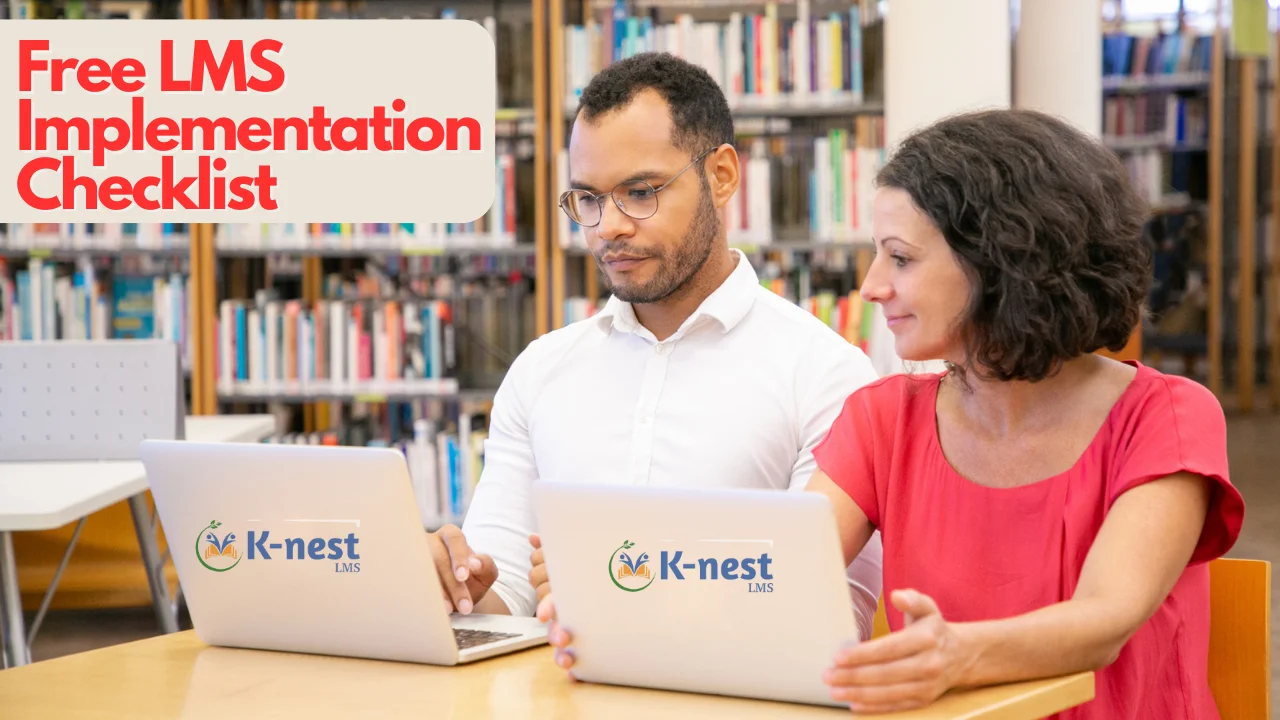Free LMS Implementation Checklist : A Step-by-Step Guide
Are you ready to revolutionize your workforce training with a top-notch Learning Management System (LMS)? Congratulations on taking this crucial step! But with so many options out there, how do you kick-start the process?
Well, our comprehensive handbook is here to guide you through every step of LMS implementation, ensuring you select the perfect platform and set it up effortlessly.

While we highlighted the strengths of K-nest LMS, our goal is to empower you to make an informed decision. We recommend researching and comparing multiple LMS platforms to find the one that best aligns with your specific needs and budget.
Why Use an LMS?
Here's a glimpse into some of the benefits of implementing an LMS:
- Streamlined Onboarding: Automate and centralize the onboarding process, saving time for both managers and new hires.
- Centralized Knowledge Hub: Create a single source of truth for company best practices and training materials.
- Cost-effectiveness: Reduce training costs associated with traditional methods such as travel, printed materials, and instructor fees by delivering content online through the LMS.
- Scalability: Easily scale your training efforts as your company grows without the need for significant additional resources or infrastructure.
- Compliance Management: Ensure regulatory compliance by easily tracking and managing employee certifications, licenses, and training requirements.
- Mobile Accessibility: Enable employees to access training materials anytime, anywhere, and from any device, promoting flexibility and convenience in learning.
- Enhanced Reporting and Analytics: Gain valuable insights into training effectiveness, learner engagement, and performance metrics through robust reporting and analytics features.
10 Steps to Successful LMS Implementation
This guide is designed for L&D professionals or training managers responsible for overseeing the entire training project, from kick-off to completion.
Step 1: Define Training Goals (2-3 days)
Collaboration is the key! Work with stakeholders (Senior managers, HR manager, Project leaders) to establish clear and measurable training objectives.
Avoid Vague Goals: Instead of aiming for "improved employee skills," define specific metrics like "Increase sales by 15% within Q3", “Reduce the defect rate of the next project by 25%”, “Improve the productivity by 10% in the next 6 months”
Step 2: Identify the Training Needs (1-2 weeks)
Uncover knowledge and skill gaps within your workforce. Talk directly to employees and supervisors to understand their learning requirements. Study about client feedback. Analyze the current defect patterns. Evaluate a group of employees within a specific technology, domain, or business sector and record their performance. This is required for a comparison at the post training stage.
Step 3: Craft Your LMS Implementation Plan (2 days)
Having a roadmap streamlines the process. Develop a detailed plan outlining timelines, milestones, platform & its integration requirements, content migration, pilot testing, resource allocation, and mainly the budgetary constraints & requirements.
Step 4: Assemble Your Implementation Team (2 days)
Identify the individuals responsible for various aspects of the LMS implementation. This may include content creators, administrators, network, and support personnel.
While budget constraints might limit team size, consider upskilling existing employees or leveraging a user-friendly LMS to minimize the need for extensive technical expertise. (E.g., going for SaaS-based LMS)
Step 5: Develop Engaging Training Content (1-3 weeks or more)
Here's where the magic happens! Create compelling training materials that resonate with your learners.
Start Small: Don't overwhelm yourself with a massive course library. Begin with a single, focused course addressing a critical training need. Make use of existing contents if any, even if they are in the form of PDF, PPT, or MS Word.
At the latest stages, you might opt for interactive videos based on SCORM standards to enhance the learning experience.
LMS Tip: Utilize your LMS's compatibility with various authoring tools to create interactive and engaging learning experiences.
Step 6: Announce the LMS Launch (2 days)
Generate excitement! Spread the word about the LMS launch through company-wide announcements, emails, and team briefings.
Highlight the Benefits: Emphasize how an LMS will empower employees with convenient, on-demand learning opportunities.
Step 7: Configure Your LMS (1-3 days)
Your chosen LMS should offer a user-friendly setup process. Here's a breakdown of key configuration tasks:
- Import User Data: Integrate your LMS with your HR system for seamless user migration.
- Assign Roles: Designate administrators and supervisors to manage the platform and user permissions.
- Customize Branding: Tailor the LMS interface to reflect your company's branding for a familiar and cohesive experience.
- Explore Integrations: Leverage your LMS's integration capabilities with popular tools to enhance functionality. For example, integrating the LMS with a live-classroom software.
Step 8: Assign Your First Course (1-2 weeks)
Put your LMS into action! Assign the initial training course to your designated user group and set a clear deadline for completion. You may also create an assessment for the course to evaluate the learners, if required.
Step 9: Monitor Course Completion Rates (1 week)
Track learner engagement. Analyze user completion rates and assessment scores to identify any areas needing improvement.
LMS Tip: Many LMS platforms provide comprehensive assessment and reporting tools to give you valuable insights into learner progress.
Step 10: Evaluate Training Effectiveness (1 day)
Demonstrate the value of LMS implementation! Assess the impact of training on achieving your predefined goals.
Gather Feedback: Collect data from learners and stakeholders to understand the overall effectiveness of the training program.
Continuous Improvement: Based on your evaluation, refine your training strategy and content for ongoing success.
Download our Free LMS Implementation Checklist
Stay organized and ensure a smooth LMS implementation process with a free checklist from a trusted LMS provider. It outlines all the essential steps you've reviewed here, along with additional resources to guide you on your journey.
Click here to to get the checklist.
Choosing the Right LMS: Finding Your Perfect Fit
The LMS market is teeming with options, each boasting unique features and functionalities. Here's how to navigate this landscape and select the platform that aligns perfectly with your organization's needs:
- Identify Your Needs: Start by clearly defining your training goals and target audience. Are you looking to onboard new hires, provide compliance training, or upskill your existing workforce? Understanding your specific requirements will help narrow down your LMS options.
- Consider Features and Functionality: LMS platforms offer a variety of features, from basic course delivery to advanced functionalities like mobile learning, gamification, and social learning tools. Prioritize the features that are most critical for your training programs.
- Budgetary Constraints: LMS solutions range in cost depending on features, scalability, and deployment options (cloud-based vs. self-hosted). Determine your budget upfront and choose an LMS that offers the best value for your investment.
- Technical Expertise: Consider your IT team's capabilities. Some LMS platforms are intuitive and user-friendly, while others require more technical expertise for setup and maintenance.
Introducing K-nest LMS: Your Trusted Training Partner
Now that you have a roadmap for selecting the right LMS, allow us to introduce K-nest LMS as a strong contender for your consideration. We understand that every organization has unique training needs, and K-nest LMS is designed to cater to a wide range of requirements.

Here's what sets K-nest LMS apart:
- Effortless User Experience: K-nest LMS boasts an intuitive and user-friendly interface, making it easy for administrators, trainers, and learners to navigate the platform with minimal training.
- Seamless Integrations: Streamline your workflow by integrating K-nest LMS with your existing HR systems and popular authoring tools. Effortlessly migrate user data and content for a smooth transition.
- Unparalleled Support: Our dedicated customer success team is here to guide you every step of the way. From implementation to ongoing support, K-nest LMS ensures you have the resources you need to succeed.
- Feature-Rich Functionality: Empower your learners with a robust feature set that includes mobile learning, gamified elements, social learning tools, and comprehensive reporting and analytics.
- Scalable and Secure: K-nest LMS is built to accommodate your organization's growth. Our secure cloud-based platform ensures the safety and privacy of your learning content and user data.
Choosing the Right LMS: A Feature Checklist
|
Feature |
Description |
Importance |
K-nest LMS |
|
|
Ease of Use |
Intuitive interface for administrators, trainers, and learners. |
High |
Yes |
|
|
Integrations |
Integrates with existing HR systems and other related tools. |
Medium |
Yes |
|
|
Support |
Dedicated customer success team for guidance and troubleshooting. |
High |
Yes |
|
|
Mobile Learning |
Enables learners to access training on their smartphones or tablets. |
Medium |
Yes |
|
|
Gamification |
Uses game mechanics like points, badges, certificates, and leaderboards to boost engagement. |
Medium |
Yes |
|
|
Social Learning |
Facilitates knowledge sharing and peer-to-peer learning through discussions and forums. |
Medium |
Yes |
|
|
Reporting & Analytics |
Provides insights into learner progress and course effectiveness. |
High |
Yes |
|
|
Scalability |
Can accommodate your organization's growth in users and courses. |
Medium |
Yes |
|
|
Security |
Secure cloud-based platform to protect learning content and user data. |
High |
Yes |
|
|
Budget |
Cost-effective solution that aligns with your budget. |
High |
|
Start Your Free Trial Today!
Ready to experience the power of K-nest LMS firsthand? We offer a free 30-day trial, allowing you to explore the platform's features and functionalities and see how it can transform your employee training.
Don't just take our word for it. Sign up for your free trial today and discover how K-nest LMS can become your trusted partner in creating a thriving learning culture within your organization!
Start Your Free Trial Today!
While we highlighted the strengths of K-nest LMS, our goal is to empower you to make an informed decision. We recommend researching and comparing multiple LMS platforms to find the one that best aligns with your specific needs and budget.
Here are some additional factors to consider when evaluating LMS options:
- Customer Reviews and Ratings: Read user reviews and ratings to gain insights into real-world experiences with different LMS platforms.
- Free Demos and Trial Periods: Many LMS providers offer free demos or trial periods. Take advantage of these opportunities to test-drive the platform before making a purchase decision.
- Scalability and Future Needs: Consider your organization's future growth plans. Choose an LMS that can scale to accommodate your evolving training requirements.
By carefully considering these factors, you can confidently select the right LMS that empowers your organization to achieve its training goals and unlock the full potential of your workforce.





